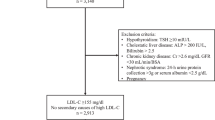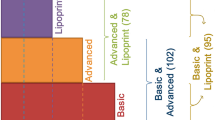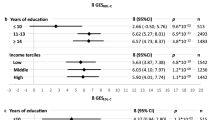Abstract
The nature of the genetic and environmental factors influencing low density lipoprotein (LDL) particle size in patients with familial combined hyperlipidaemia (FCHL) is under debate. We measured LDL peak particle size in 553 subjects belonging to 48 Finnish FCHL families. Individuals with high triglyceride (TG) concentrations (phenotype IV) or combined hyperlipidaemia (phenotype IIB) had significantly smaller LDL particles than those with hypercholesterolaemia (phenotype IIA) or unaffected subjects (P<0.001). In stepwise regression analyses, serum TGs (r2=43%, P<0.001) and high density lipoprotein cholesterol (HDL-C) (r2=4.5%, P<0.001) were the only significant predictors of LDL peak particle size. Familial correlations support the conclusion that LDL peak particle size is familial, and most probably influenced by genes in these families. Segregation analysis of LDL peak particle size, a quantitative trait, was performed to model this genetic influence. Our results suggest a polygenic background for LDL size with a recessive major gene that may contribute to large LDL peak particle size in women. Serum TG and HDL-C concentrations predict the majority of variations in LDL particle size.
Similar content being viewed by others
Log in or create a free account to read this content
Gain free access to this article, as well as selected content from this journal and more on nature.com
or
References
Goldstein JL, Schrott HG, Hazzard WR, Bierman EL, Motulsky AG . Hyperlipidemia in coronary heart disease II. Genetic analysis of lipid levels in 176 families and delineation of a new inherited disorder, combined hyperlipidemia J Clin Invest 1973 52: 1544–1568
Nikkilä EA, Aro A . Family study of serum lipids and lipoproteins in coronary heart disease Lancet 1973 1: 954–958
Porkka KVK, Nuotio I, Pajukanta P et al. Phenotype expression in familial combined hyperlipidaemia Atherosclerosis 1997 133: 245–253
de Graaf J, Stalenhoef AFH . Defects of lipoprotein metabolism in familial combined hyperlipidaemia Curr Opin Lipidol 1998 9: 189–196
Aouizerat BE, Allayee H, Bodnar J et al. Novel genes for familial combined hyperlipidemia Curr Opin Lipidol 1999 10: 113–122
Krauss RM, Burke DJ . Identification of multiple subclasses of plasma low density lipoproteins in normal humans J Lipid Res 1982 23: 97–104
Austin MA, Hokanson JE, Brunzell JD . Characterization of low-density lipoprotein subclasses: methodologic approaches and clinical relevance Curr Opin Lipidol 1994 5: 395–403
Lamarche B, Tchernof A, Moorjani S et al. Small, dense low-density lipoprotein particles as a predictor of the risk of ischemic heart disease in men: prospective results from the Québec Cardiovascular Study Circulation 1997 95: 69–75
McNamara JR, Campos H, Ordovas JM, Peterson J, Wilson PW, Schaefer EJ . Effect of gender, age, and lipid status on low density lipoprotein subfraction distribution. Results from the Framingham Offspring Study Arteriosclerosis 1987 483–490
Tan CE, Foster L, Caslake MJ et al. Relations between plasma lipids and postheparin plasma lipases and VLDL and LDL subfraction patterns in normolipemic men and women Arterioscler Thromb Vasc Biol 1995 15: 1839–1848
Reaven GM, Ida Chen Y-D, Jeppesen J, Maheux P, Krauss RM . Insulin resistance and hyperinsulinemia in individuals with small, dense, low density lipoprotein particles J Clin Invest 1993 92: 141–146
Austin MA, Brunzell JD, Fitch WL, Krauss RM . Inheritance of low density lipoprotein subclass patterns in familial combined hyperlipidemia Arteriosclerosis 1990 10: 520–530
Bredie SJH, Kiemeney LA, de Haan AFJ, Demacker PNM, Stalenhoef AFH . Inherited suspectibility determines the distribution of dense low-density lipoprotein subfraction profiles in familial combined hyperlipidemia Am J Hum Genet 1996 58: 812–822
Edwards KL, Mahaney MC, Motulsky AG, Austin MA . Pleiotropic genetic effects on LDL size, plasma triglyceride, and HDL cholesterol in families Arterioscler Thromb Vasc Biol 1999 19: 2456–2464
Austin MA, King MC, Vranizan KM, Krauss RM . Atherogenic lipoprotein phenotype. A proposed genetic marker for coronary heart disease risk Circulation 1990 82: 495–506
Porkka KV, Viikari JS, Rönnemaa T, Marniemi J, Åkerblom HK . Age and gender specific serum lipid and apolipoprotein fractiles of Finnish children and young adults. The Cardiovascular Risk in Young Finns Study Acta Paediatr 1994 83: 838–848
Vartiainen P, Puska P, Jousilahti P, Korhonen HJ, Tuomilehto J, Nissinen A . Twenty-year trends in coronary risk factors in north Karelia and in other areas of Finland Int J Epidemiol 1994 23: 495–504
Vakkilainen J, Jauhiainen M, Ylitalo K et al. LDL particle size in familial combined hyperlipidemia. Effects of serum lipids, lipoprotein-modifying enzymes, and lipid transfer proteins J Lipid Res 2002 43: 598–603
Vakkilainen J, Porkka KVK, Nuotio I et al. Glucose intolerance in familial combined hyperlipidaemia Eur J Clin Invest 1998 28: 24–32
Ylitalo K, Pajukanta P, Meri S et al. Serum C3 but not plasma acylation-stimulating protein is elevated in Finnish patients with familial combined hyperlipidemia Arterioscler Thromb Vasc Biol 2001 21: 838–843
S.A.G.E. Statistical analysis for genetic epidemiology, Version 4.0 Beta 6, 2000. Case Western Reserve University, Cleveland, 2000
S.A.G.E. Statistical analysis for genetic epidemiology, Version 3.1 Beta 6, 1997. Case Western Reserve University, Cleveland, 1997
Bonney GE . On the statistical determination of major gene mechanisms in continuous human traits: regressive models Am J Hum Genet 1984 18: 731–749
Akaike J . A new look at the statistical model identification IEEE Transautomat Control 1974 AC-19: 716–729
de la Chapelle A . Disease gene mapping in isolated human populations: the example of Finland J Med Genet 1993 30: 857–865
Packard CJ, Shepherd J . Lipoprotein heterogeneity and apolipoprotein B metabolism Arterioscler Thromb Vasc Biol 1997 17: 3542–3556
Jarvik GP . Complex segregation analyses: uses and limitations Am J Hum Genet 1998 63: 942–946
Veerkamp MJ, de Graaf J, Bredie SJ, Hendriks JC, Demacker PN, Stalenhoef AF . Diagnosis of familial combined hyperlipidemia based on lipid phenotype expression in 32 families: results of a 5-year follow-up study Arterioscler Thromb Vasc Biol 2002 22: 274–282
Cullen P, Farren B, Scott J, Farrall M . Complex segregation analysis provides evidence for a major gene acting on serum triglyceride levels in 55 British families with familial combined hyperlipidemia Arterioscler Thromb 1994 14: 1233–1249
Jarvik GP, Brunzell JD, Austin MA, Krauss RM, Motulsky A, Wijsman E . Genetic predictors of FCHL in four large pedigrees. Influence of apoB level major locus predicted genotype and LDL subclass phenotype Arterioscler Thromb 1994 14: 1687–1694
Allayee H, Aouizerat BE, Cantor RM et al. Families with familial combined hyperlipidemia and families enriched for coronary artery disease share genetic determinants for the atherogenic phenotype Am J Hum Genet 1998 63: 577–585
Austin MA, King MC, Vranizan KM, Newman B, Krauss RM . Inheritance of low-density lipoprotein subclass patterns: results of complex segregation analysis Am J Hum Genet 1988 43: 838–846
Austin MA, Jarvik GP, Hokanson JE, Edwards K . Complex segregation analysis of LDL peak particle diameter Genet Epidemiol 1993 10: 599–604
Juo SHH, Bredie SJH, Kiemeney LA, Demacker PNM, Stalenhoef AFH . A common genetic mechanism determines plasma apolipoprotein B levels and dense LDL subfraction distribution in familial combined hyperlipidemia Am J Hum Genet 1998 63: 586–594
Hokanson JE, Austin MA, Zambon A, Brunzell JD . Plasma triglyceride and LDL heterogeneity in familial combined hyperlipidemia Arterioscler Thromb 1993 13: 427–434
Acknowledgements
We thank Seppo Sarna for statistical advice, and Helinä Perttunen-Nio, Ritva Marjanen, and Leena Lehikoinen for technical assistance. The results of familial correlations and segregation analyses were obtained by means of the program package SAGE which is supported by US Public Health Services Resource grant (1 P41 RR03655) from the National Center for Research Resources. This work was supported by grants from the Finnish Academy, Finnish Heart Foundation, Duodecim Foundation, Maud Kuistila Foundation, Helsinki University Central Hospital Research Foundation, and European Commission contract ‘European Multicenter Study on Familial Dyslipidemias With Premature Coronary Heart Disease (EUFAM)’, contract number BMH4-CT96-1678. P Pajukanta, RM Cantor and L Peltonen were supported in part by the National Institutes of Health Program Project grant HL-28481.
Author information
Authors and Affiliations
Corresponding author
Rights and permissions
About this article
Cite this article
Vakkilainen, J., Pajukanta, P., Cantor, R. et al. Genetic influences contributing to LDL particle size in familial combined hyperlipidaemia. Eur J Hum Genet 10, 547–552 (2002). https://doi.org/10.1038/sj.ejhg.5200844
Received:
Revised:
Accepted:
Published:
Issue date:
DOI: https://doi.org/10.1038/sj.ejhg.5200844
Keywords
This article is cited by
-
Linkage and association analyses identify a candidate region for apoB level on chromosome 4q32.3 in FCHL families
Human Genetics (2010)
-
Is it LDL particle size or number that correlates with risk for cardiovascular disease?
Current Atherosclerosis Reports (2008)



